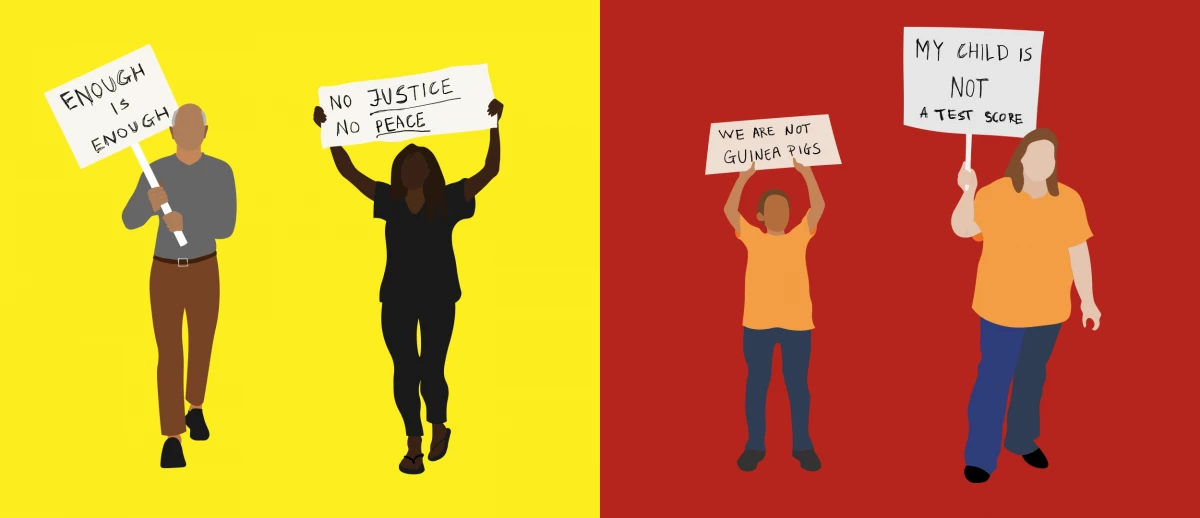- Home /
- Impact /
- News & Commentary /
- Influential Users in the Common Core and Black Lives Matter Social Media Conversation
Influential Users in the Common Core and Black Lives Matter Social Media Conversation
We analyzed Twitter discussions around two very different topics and found striking similarities in how political discussions evolve online.

Credit: Judy Zhang
Area of Study
Tags
This article is part of an ongoing Research Summaries series at CSMaP where we provide complimentary articles to our published research for journalists, policymakers, peer-researchers, and those interested in the relationship between social media and politics. This week, we wrote about a recent CSMaP data report, which analyzes the impact of influential Twitter users in the BLM and Common Core movements.
In May 2020, shock swept the nation as a video of George Floyd’s death circulated on social media and the news. This moment reignited Black Lives Matter (BLM) protests with people taking to the streets and social media to decry police brutality toward Black people in America. As more high-profile killings of Black Americans at the hands of law enforcement were brought to public attention, support for the movement grew.
This wasn’t the first time that BLM appeared on social media. In 2013, the death of Trayvon Martin sparked the first use of the hashtag “#BlackLivesMatter” on Twitter. Despite the movement’s decentralized structure, a central set of principles developed focusing on community control of public safety, reducing Black youth incarceration, and refocusing funds toward public education and other policy goals.
At the same time, a country-wide debate over education standards was taking place. In 2009, the federal government standardized education administration in a set of policies, which became known as the Common Core State Standards. By 2010, 45 states and Washington, D.C. had adopted Common Core. The standards set goals for students in reading, writing, and math to prepare students for “college and life beyond.” Although state governments, educators, and researchers collaborated on the standards, they were widely criticized online.
In our research, we examined these two movements because we were interested in how different types of online political discussion develop. BLM was a community-led movement with high saliency in public discourse, while Common Core was a more technocratic policy that rarely broke into mainstream discussion. By comparing the two, we sought to draw out similarities and differences to explain how online discussions shape movements over time and, specifically, determine who has the most influence in shaping those discussions.
The Study
Analyzing a dataset of more than 6 million tweets and nearly 900,000 unique users related to Common Core, and nearly 150 million tweets and 13 million unique users related to BLM, CSMaP researchers first sought to determine what type of users matter, focusing on three areas:
Political vs. apolitical — Do political users (those who primarily tweet about politics) or apolitical users (those who primarily tweet about subjects other than politics) have more influence?
Elites/experts vs. amateurs — Do elite users (those with credentials, high follower counts, and verified status, such as politicians and media) or amateur users (non-credentialed) matter more?
Engagement — Does the amount of engagement with the topic (tweeting about it infrequently vs. frequently) make a difference?
Next, the study sought to measure how users matter, looking at two categories:
Production — How much content does each type of user produce related to other groups?
Reach — How far do tweets by each type of user go?
The Findings
In both the BLM and Common Core discussions, we found that political amateurs produced the most tweets. But who had wider reach, meaning their tweets had more impact and more influence in driving the conversation, varied depending on the topic.
Production
Although the number of political users was relatively small (18 to 27 percent of all users), they comprised more than half the tweets in both discussions (57 percent in Common Core and 55 percent in BLM). Among this group, political amateurs produced the most tweets (37 percent in Common Core and 48 percent in BLM), as shown in Table 4.
Reach
Overall, political users tweeted more and had wider reach. But the type of user, and why they had more reach, was different for each topic.
In the BLM conversation, high follower count and verified status made a difference: Political elites had a wider reach than any other group, accounting for six times as much reach as their number of tweets suggest. (In Common Core, tweets from political elites only went 1.5 times further.) But in the Common Core discussion, the volume of tweets made more of a difference: Political amateurs had wider reach than any other group, simply because they tweeted more. Table 7 shows the breakdown in reach by account type.
Conclusion
In both Common Core and BLM movements, users who didn’t generally use Twitter for political purposes had the highest number of tweets. However, political users drive and influence the conversation by receiving the most retweets and engagement with their content. Looking to the future, the team plans to build on this work by developing a more general theoretical framework for better understanding who drives online conversations and why.
Read the Original Medium Post Here.